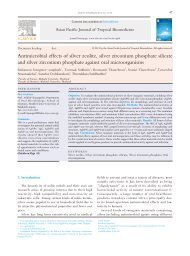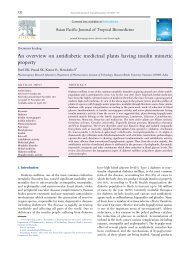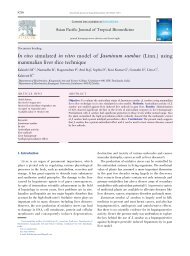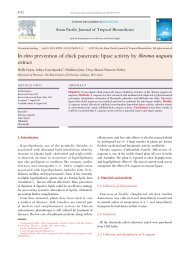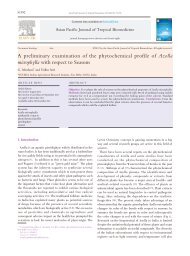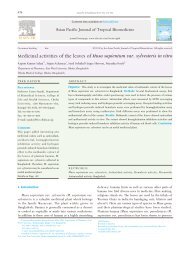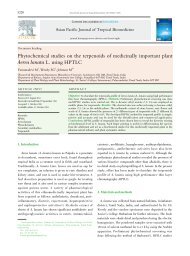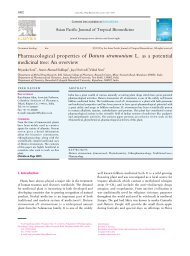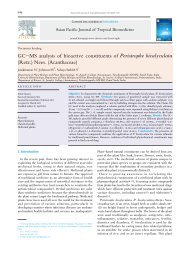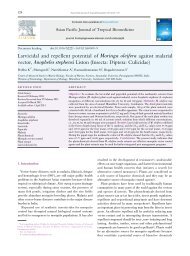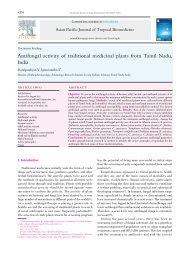Preliminary phytochemical studies on the methanolic ... - Apjtb.com
Preliminary phytochemical studies on the methanolic ... - Apjtb.com
Preliminary phytochemical studies on the methanolic ... - Apjtb.com
Create successful ePaper yourself
Turn your PDF publications into a flip-book with our unique Google optimized e-Paper software.
4. Discussi<strong>on</strong><br />
Johns<strong>on</strong> Marimuthu @ Ant<strong>on</strong>isamy et al ./Asian Pacific Journal of Tropical Biomedicine (2012)S79-S82 S81<br />
The plants known as medicinal, are rich in sec<strong>on</strong>dary<br />
metabolites which include alkaloids, glycosides, flav<strong>on</strong>oids,<br />
insecticides, steroids, related active metabolites. They are of<br />
great medicinal value and have been extensively used in <strong>the</strong><br />
drug and pharmaceutical industry. Recently, a number of<br />
<str<strong>on</strong>g>studies</str<strong>on</strong>g> have been reported <strong>on</strong> <strong>the</strong> phytochemistry of plants<br />
across <strong>the</strong> world. In <strong>the</strong> present investigati<strong>on</strong>, four plants<br />
flowers have been selected from India for <str<strong>on</strong>g>phytochemical</str<strong>on</strong>g><br />
screening <strong>on</strong> <strong>the</strong> basis of traditi<strong>on</strong>al uses. The present<br />
phytochemcial study revealed <strong>the</strong> presence of phenols in<br />
all selected plants flower extracts, coumarin in H. isora,<br />
S. campanulata and A. leptopus, alkaloids in H. isora, S.<br />
campanulata and T. grandiflora, tannins, xanthoproteins<br />
and carboxylic acid in H. isora and A. leptopus, sap<strong>on</strong>ins,<br />
steroids, triterpenoids and aminoacids <strong>on</strong>ly in A. leptopus.<br />
Many tannin-c<strong>on</strong>taining drugs are used in medicine as<br />
astringent. They are used in <strong>the</strong> treatment of burns as<br />
<strong>the</strong>y precipitate <strong>the</strong> proteins of exposed tissues to form<br />
a protective covering. They are also medicinally used as<br />
healing agents in inflammati<strong>on</strong>, leucorrhoea, g<strong>on</strong>orrhoea,<br />
burns, piles and as antidote. Tannins has been found to<br />
have antiviral, antibacterial, antiparasitic effects, antiinflammatory,<br />
antiulcer and antioxidant property for<br />
possible <strong>the</strong>rapeutic applicati<strong>on</strong>s[29-31]. In <strong>the</strong> present study<br />
we revealed <strong>the</strong> tannins, xanthoproteins and carboxylic<br />
acid presence in H. isora and A. leptopus. In additi<strong>on</strong> to<br />
<strong>the</strong> previous observati<strong>on</strong> <strong>the</strong> present study revealed and<br />
supplemented <strong>the</strong> phyto-c<strong>on</strong>stituents from <strong>the</strong> flower<br />
extracts of H. isora and A. leptopus.<br />
Sap<strong>on</strong>ins are c<strong>on</strong>sidered as a key ingredient in traditi<strong>on</strong>al<br />
Chinese medicine and are resp<strong>on</strong>sible for most of <strong>the</strong><br />
observed biological effects. Sap<strong>on</strong>ins are known to produce<br />
inhibitory effect <strong>on</strong> inflammati<strong>on</strong>. There is tremendous,<br />
<strong>com</strong>mercially driven promoti<strong>on</strong> of sap<strong>on</strong>ins as dietary<br />
supplements and nutriceuticals. Sap<strong>on</strong>in possesses specific<br />
physical, chemical and biological activities that make<br />
<strong>the</strong>m useful as drugs. Some of <strong>the</strong>se biological properties<br />
include antimicrobial, anti-inflammatory, anti-feedent,<br />
and hemolytic effects[32,33]. These observati<strong>on</strong>s cited<br />
<strong>on</strong> <str<strong>on</strong>g>phytochemical</str<strong>on</strong>g> <strong>com</strong>pounds support our findings <strong>on</strong><br />
<strong>the</strong> usefulness of A. leptopus in traditi<strong>on</strong>al medicament.<br />
Coumarin has been used as anti-coagulant drugs and to<br />
treat lymphedema[34]. In <strong>the</strong> present study we observed<br />
<strong>the</strong> coumarin presence in <strong>the</strong> <strong>methanolic</strong> flower extracts<br />
of H. isora, S. campanulata and A. leptopus. The results of<br />
<strong>the</strong> present study supplement <strong>the</strong> folkloric usage and <strong>the</strong><br />
previous observati<strong>on</strong>s of A. leptopus and suggest that some<br />
of <strong>the</strong> flower extracts possess <strong>com</strong>pounds with anticoagulant<br />
properties that can be used as anticoagulant agents in <strong>the</strong><br />
near future.<br />
Medical use of alkaloid plants has a l<strong>on</strong>g history, and<br />
thus when <strong>the</strong> first alkaloids were syn<strong>the</strong>sized in <strong>the</strong> 19th<br />
century, <strong>the</strong>y immediately found applicati<strong>on</strong> in clinical<br />
practice. In additi<strong>on</strong>, alkaloids possess anti-inflammatory,<br />
anti-asthmatic, and anti-anaphylactic properties<br />
with c<strong>on</strong>sequences of altered immunological status in<br />
vivo. Fur<strong>the</strong>rmore, alkaloid which is <strong>on</strong>e of <strong>the</strong> largest<br />
<str<strong>on</strong>g>phytochemical</str<strong>on</strong>g> groups in plants has amazing effect <strong>on</strong><br />
humans and this has led to <strong>the</strong> development of powerful<br />
pain killer medicati<strong>on</strong>s[35,36]. In <strong>the</strong> present study we also<br />
c<strong>on</strong>firmed <strong>the</strong> presence of alkaloids in <strong>the</strong> <strong>methanolic</strong> flower<br />
extracts of H. isora, S. campanulata and T. grandiflora and<br />
that augments <strong>the</strong> use of alkaloid in global pharmaceutical<br />
market. Flav<strong>on</strong>oids, <strong>the</strong> major group of phenolic <strong>com</strong>pounds<br />
are reported for <strong>the</strong>ir antimicrobial, antiviral and spasmolytic<br />
activity. Flav<strong>on</strong>oids are able to scavenge hydroxyl radicals,<br />
superoxide ani<strong>on</strong> radicals and lipid peroxy radicals, which<br />
highlights many of <strong>the</strong> flav<strong>on</strong>oid health-promoting functi<strong>on</strong>s<br />
in organism. They are important for preventi<strong>on</strong> of diseases<br />
associated with oxidative damage of membrane, proteins<br />
and DNA. Flav<strong>on</strong>oids in human diet may reduce <strong>the</strong> risk<br />
of various cancers, as well as preventing menopausal<br />
symptoms. Flav<strong>on</strong>oids, <strong>on</strong> <strong>the</strong> o<strong>the</strong>r hand, are potent watersoluble<br />
antioxidants and free radical scavengers, which<br />
prevent oxidative cell damage and have str<strong>on</strong>g anti-cancer<br />
activity[37-39]. Phytochemical <str<strong>on</strong>g>studies</str<strong>on</strong>g> <strong>on</strong> <strong>the</strong> <strong>methanolic</strong><br />
flower extracts of H. isora, S. campanulata, A. leptopus and<br />
T. grandiflora revealed <strong>the</strong> presence of carbohydrates,<br />
steroids, alkaloids, glycosides, tannins, sap<strong>on</strong>ins, flav<strong>on</strong>es,<br />
and phenolic <strong>com</strong>pounds. The antimicrobial activity of H.<br />
isora, S. campanulata A. leptopus and T. grandiflora may<br />
be due to <strong>on</strong>e/more group of above phyto-c<strong>on</strong>stituents.<br />
From <strong>the</strong> results, it can be c<strong>on</strong>cluded that <strong>the</strong> <strong>methanolic</strong><br />
flower extracts of H. isora, S. campanulata, A. leptopus and<br />
T. grandiflora find use as broad-spectrum antimicrobial,<br />
bioactive agent after extensive investigati<strong>on</strong>. Fur<strong>the</strong>r work<br />
will emphasize <strong>the</strong> isolati<strong>on</strong> and characterizati<strong>on</strong> of active<br />
principles resp<strong>on</strong>sible for bio-efficacy and bioactivity.<br />
C<strong>on</strong>flict of interest statement<br />
We declare that we have no c<strong>on</strong>flict of interest.<br />
References<br />
[1] Badgujar VB, Jain PS, Pal SC, Patil RR. Antimicrobial activity of<br />
stem bark of Helicteres isora. Indian J Nat Prod 2006; 22(2): 34-35.<br />
[2] Kirtikar KR, Basu BD. Indian medicinal plants. Dehradun, India:<br />
Internati<strong>on</strong>al Book Distributors; 1995, p. 371-372.<br />
[3] Singh KK, Saha S, Maheshwari JK. Ethnobotany of Helicteres isora<br />
Linn. in Kheri district, Uttar Pradesh. J Ec<strong>on</strong> Tax<strong>on</strong> Bot 1985; 7(2):<br />
487-492.<br />
[4] Bean MF, Antoun M, Abrams<strong>on</strong> D, Chang CJ, Mc Laughlin JL,<br />
Cassady JM. Cucurbitacin B and isocucurbitacin B Cytotoxic<br />
<strong>com</strong>p<strong>on</strong>ents of Helicteres isora. J Nat Prod 1985; 48: 500-503.<br />
[5] Kumar G, Sharmila Banu G, Murugesan AG, Rajasekara Pandian<br />
M. Hypoglycaemic effect of Helicteres isora bark extracts in rats.<br />
J Ethnopharmacol 2006a; 107: 304-307.<br />
[6] Kumar G, Murugesan AG, Rajasekara Pandian M. Effect of



